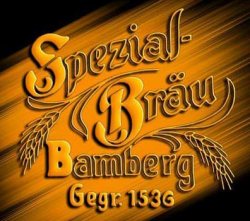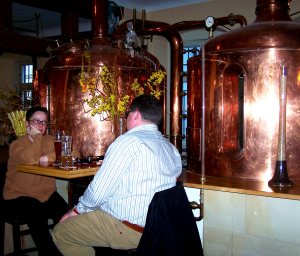 |

|
|

|
|
|
 |

home
about
features
A-Z
books

|

|

features
|

| |
Bamberg Part II - Breweries & Pubs
by Willard Clarke, 09/07
The oldest Rauchbier brewery in Bamberg is the Christian Merz Spezial brewpub on Obere Köningstrasse. It was founded in 1536 and originally lagered its beers in caves cut from the sandstone on the Stephansberg hill. The serving area of its beer garden, the Spezial-Keller on Oberer Stephansberg, marks the entrance to the lager cellar.
Today beer is brewed, fermented and lagered behind the pub, which also has its own maltings. While the tavern is charmingly old fashioned, with spacious wood-panelled rooms, the brewery has been brought up to date, with due consideration given to the environment. There are solar panels on the roof for energy while only organic malt and hops are used.
Christian Merz uses around 70% smoke malt in its beers. They include the main brand, Rauchbier Lager (4.7%), a 5.2% wheat beer and 5.3% March beer. There is a Bock in season and an occasional 4.9% Ungespundet or "unbunged" beer. This is a Bavarian speciality, an unfiltered lager that has had the bung removed from the cask to avoid over-carbonation during maturation.
The Rauchbier is red/bronze in colour with a smoky aroma, smoky malt in the mouth with gentle hop resins, light fruit and a touch of toffee. The finish is dry, smoky and hoppy with tart fruit.
|
|

|
The Fässla (Little Barrel) pub and brewery stand across the road from Christian Merz. It's popular with card players, who sit in the corridor off the street. The main bar is known as the Schwemme - literally, the swimming pool, as a result of all the liquid consumed there. The brewery, founded in 1649, is beyond a courtyard: when I attempted to enter, a man in overalls appeared and waved me away with an abrupt "Verboten!" (Not Allowed). The main draught beers are Lager and Gold Pils while wheat beers and a strong seasonal Bock are bottled.
|
|
It's easy to get confused by so many "originals" and "firsts" in Bamberg. While Christian Merz is the oldest brewer of Rauchbier, the first brewpub in the city predates it by three years. The Klosterbräu, in a fine setting
by the river and with a part-sandstone and part-half-timbered, creeper-clad exterior, does not despite the name have monastic origins: kloster means cloister. It was first known as the Prince-Bishops' Brown Beer House
and the stone crest above the entrance, dated 1533, belonged to the ruling Prince-Bishops. It was the overweening power of the
|
Prince-Bishops in Germany that led to Martin Luther's revolt against Rome and the
ensuing Reformation. When Luther was on trial for heresy, he was refreshed by draughts of beer from Einbeck in Saxony.
The Klosterbräu was secularised in the 18th century and has been run since the 19th by members of the Braun family. One of the beers brewed on site is a Braunbier and this gives rise to endless jokes as to whether the beer is named after the original Prince-Bishops' beers or the current Braun family.
Just sit back and enjoy it, along with a much darker black beer, a Pils and, according to season, a Bock, Black Bock or Maibock. There's even a Braun Weisse, another joke in itself. Weisse means both White and Wheat, so you are drinking a Brown White Wheat beer. You can sit in a delightful courtyard in summer, or in one of the wood-panelled rooms. The regional food is delicious, but if you don't fancy pork, sauerkraut or dumplings you had better dine elsewhere.
You could do worse than catch the Number 6 bus from the central bus station and make the short, 12-minute ride to the suburb of Bischberg. The Brauereigasthof zur Sonne (the Sun Brewery and Guest House, below) stands on a corner of the main road and has been brewing since 1587. As it is close to the confluence of the Regnitz and the Main, there would have been no shortage of ice for lagering beer centuries ago.
Pub and brewery have been in the hands of the Schumann family since 1856 and Peter Schumann, the resident chef, has won many plaudits for his cooking: the walls of the pub are lined with his plaques and certificates.
Peter's brother Christian is the brewer, using the small plant visible through windows in an adjoining building. He brews an Urtyp Hell - a pale lager: Urtyp means "our type" or house brew - a Dunkel or dark lager, and a Pils. The beers are widely using in cooking: the menu lists such dishes as pork in dark beer, medallions of pork and bacon in beer, and pork schnitzel in beer. But there are plenty of alternatives and much use is made of local produce. I had the good fortune to visit during the asparagus season and enjoyed both asparagus soup and asparagus as a main course.
|
|

|
The beers are excellent. The Hell is floral and hoppy with a delicious hint of citrus, the Dunkel has raisin fruit, biscuity malt and gentle hops, while the Pils has toasted malt, herbal hops and light citrus fruit.
The Sonne is not - heaven forbid - a gastropub but an unspoilt, comfortable inn that happens to sell good food. It even has a Stammtisch, a table set aside for regulars, who are there strictly for the beer.
And before you catch the bus back to the centre of Bamberg, don't miss - if you are of the correct persuasion - the murals in the Gents.
A stroll along the banks of the Rhein-Main-Danube canal brings you to a suburb with the splendid name of Wunderburg. It has two breweries, standing almost opposite on the main street. Keesmann dates from 1867. It
has several spacious rooms and a large courtyard for summer drinking: the modern brewery is visible from here. The Herren Pils (Men's Pils, ladies be warned) was the best version of the style I enjoyed in Bamberg. It's exceptionally pale with a superb aroma of lightly toasted malt, herbal and grassy hops and a hint of honey. Bitter hop resins dominate the mouth with juicy malt and continuing honey sweetness. The finish lingers, with herbal hops, tangy fruit, biscuity malt and a final dry and bitter end.
Just a step across the road brings you to the small beer garden that fronts the Mahr's-Bräu tavern and brewery. Inevitably, visiting Brits have dubbed it the Mars Bar. The brewery dates from 1602 and, unlike its neighbour, is more in the central European tradition of breweries, with a tall, imposing chimney and a multi-storeyed redbrick building. A small entrance from the garden leads into several spacious and cool rooms, with low beams and polished wood.
I sampled the Hell, pale gold in colour with sweet, toasted malt, light hops and lemon fruit on the nose and bitterness building in the mouth, balanced by juicy malt and tart fruit. The finish is dry and bitter with biscuity malt, herbal hops and tangy fruit. The brewery also produces a Pils, a wheat beer, an "unbunged" lager and several seasonal Bocks.

|
|
Brewing is not locked in the past in Bamberg. Just a few doors from the Schlenkerla, a new brewpub opened in 2004, the first since 1887. Ambräusianum is owned by Michael Mahr, a member of the local brewing dynasty. The mashing and boiling coppers are on display in the main bar. A Helles (pale and cloudy), Dunkel (aromatic, fruity and biscuity) and a fruity and dry Wheat beer are on offer and can be sampled in small glasses from a tasting tray.
But you can't escape the history. A long haul up to the Michaelsberg hill brings you to the monastery where the former lagering cellars are now used to house an
|
excellent museum, with a video about brewing in Franconia and a vast range of old brewing vessels on display. There's a beer garden next door while in the restaurant I sampled a Dunkler Bock, strong black lager, brewed for the monastery by Trunk of Bad Staffelstein. The beer has dark, chewy grain, chocolate and spicy hops on the aroma and palate and a bittersweet finish with dark malt, chocolate and gentle hops. Mahr's Pils, and both Heller and Spezial smoked beers are also available.
It was a memorable end to my trip. I didn't manage to visit every brewery in the city and the magic of the place is already pulling me back.
But Bamberg is not some Franconian version of Brigadoon, the mythical Scottish Highlands village that appears just once every 100 years. Bamberg is alive and real. It represents the past and the present of brewing, and will stand forever. Go, marvel and drink deep.
Getting there
Air-Berlin flies from Stansted to Nuremberg, then a 45-minute train journey to Bamberg.
The pubs and breweries
Ambräusianum: 10 Dominikanerstrasse, 96049. Tel: 0951 509 0262.
Fassla: 19-21 Obere Köningstrasse, 96052. Tel 0951 26516/22998. Accommodation.
Heller-Brau Trum: 27-31 Oberer Stephansberg, 96049. Tel: 0951 56060
Schlenkerla Tavern: 6 Dominikanerstasse, 96049. Tel: 0951 56060. Closed Tuesday.
Keesmann: 5 Wunderburg, 96050. Tel: 0951 98 1980.
Klosterbräu: 1-3 Obere Mühlbrucke, 96049. Tel: 0951 57722
Mahr's-Bräu: 10 Wunderburg, 96050. Tel: 0951 915170.
Spezial: Chistian Merz, 10 Obere Köningstrasse, 96052. Tel: 0951 24304. Accom.
Bischberg Zur Sonne: 2 Regnitzstrasse, Bischberg 96120. Tel: 0951 62571. Accom.
Part I - Visiting Bamberg, and the Heller brewery
|
|
home
about
features
A-Z
books
|

